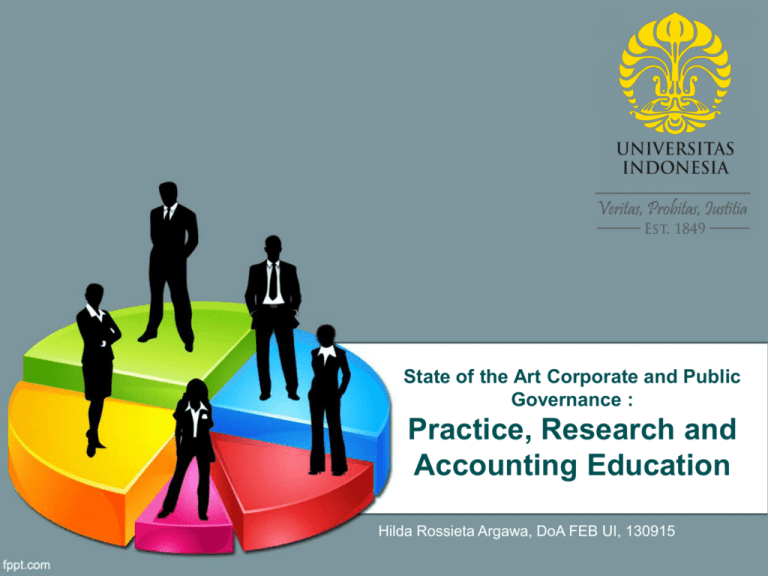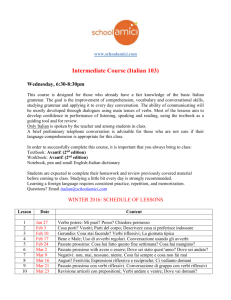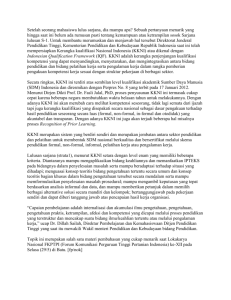39. 18 Sept_Bidang Ilmu Governance_Hielda
advertisement

State of the Art Corporate and Public Governance : Practice, Research and Accounting Education Hilda Rossieta Argawa, DoA FEB UI, 130915 State of the Art Corporate and Public Governance : Practice, Research and Accounting Education What is Good Governance (GG)? How is the development of GG Context ? How is “state of the art” of current : GG Practice ? GG Research ? How is the expected role of accountant in GG? What competencies does accountant need to perform their role? How should the competencies be incorporated in the Education System ? (KKNI Approach) Overview of KKNI Approach HRA, DoA FEB UI, 130915 2 What is Good Governance (GG)? Defintions : The way “ … power is exercised through a country’s economic, political, and social institutions.” – the World Bank’s Poverty Reduction Strategy Paper (PRSP) Handbook. Mechanisms for assuring good governance have three key elements: Internal rules and restraints (for example, internal accounting and auditing systems, independence of the judiciary and the central bank, civil service and budgeting rules); “Voice” and partnership (for example, public-private deliberation Role of councils, and service delivery surveys to solicit client feedback); accountant and Competition (for example, competitive social service delivery, private participation in infrastructure, alternative dispute resolution mechanisms, and outright privatization of certain market-driven activities). – World Development Report, 1997. http://web.worldbank.org/WBSITE/EXTERNAL/COUNTRIES/MENAEXT/EXTMNA REGTOPGOVERNANCE/0,,contentMDK:20513159~menuPK:1163245~pagePK:3 4004173~piPK:34003707~theSitePK:497024,00.html, accessed at 140915 HRA, DoA FEB UI, 130915 3 How is the development of GG Context ? Indonesian Context : Economic Crisis 1998 Pre-crisis (1966-1988 / New Order) : Centralised, Controlled market economy, Limited privatisation and deregulation Post – crisis ( 1998 – now / Reformation Era) : Decentralised (Local Government Law No. 2/1999, update by No. 32/2004; Balanced public financing between Central and Local Government, Law No 25/1999. updated by No. 33/2004) Open market economy New public management Public and private partnership www.economist-suweca.blogspot.co.id, accessed at 13 Sept. 2015 www.danangsucahyo.blogspot.co.id, accessed at 13 Sept. 2015 HRA, DoA FEB UI, 130915 4 How is the development of GG Context ? (Continued) International Context : (Samuel, 1988; Colin, 1989; Watkins and Arrington, 2007) UK Context : Privatisation : the return of conservative government lead by Thatcher in 1979 (Samuel, 1988) Transferring assets ownership from the public to the private sector US Context : Reagan’s Republican revolution in 1981 : deregulation/ relaxation of regulatory issues New Public Management (NPM) : managing public sector using private ways of management Following Reagan, Clinton introduced The National Performance Review (NPR) in 1992 HRA, DoA FEB UI, 130915 5 How is the development of GG Context ? (Continued) International Context : (Samuel, 1988; Colin, 1989; Watkins and Arrington, 2007) Similarity between UK and US context : Changing the issues of ‘efficacy’ to ‘efficiency’ in public sector Main motivation : provide better public goods and services to the society Introducing market influence on the economic allocation in public sector The effect on Good Governance Development: The distinction between public and private become blurred Corporate governance : Rooted in the agency theory (Jensen and Meckling, 1976) Assumptions : division between owners/investors as principals and managers as their agents market mechanism as primary mechanism to discipline the agents The important roles of contract and property rights HRA, DoA FEB UI, 130915 6 How is the development of GG Context ? (Continued) The effect on Good Governance Development: The distinction between public and private become blurred Public Governance under NPM : Who is the owner? Citizen as the ultimate owner who pay the tax? Who is the agent? Government Officials? Local Government Leader? How is the entity’s financing? From the tax money? From the private investor? Hybrid financing (Public Private Partnership? ) Do Good Governance Principles in the Corporate context (TARIF) similar to that in Public Sector Context? Do they have similar agency problems? (shirking, expropriation, agency cost ) How is the role of contract and property rights compared to the role of government as the agent of the public? HRA, DoA FEB UI, 130915 7 How is “state of the art” of current GG Practice? The “state of the art” of current GG practice focuses on the key elements of GG mechanism relevant to accountant in any context: Accounting System : International Financial Reporting Standard (IFRS) /PSAK; Pernyataan Standar Akuntansi Pemerintahan (PSAP) Auditing System : Standar Pemerikasan Akuntan Publik/ (SPAP) ; Standard Pemeriksaan Keuangan Negara (SPKN) Budgeting Rules : laws concerning decentralisation (UU No. 2/1999, update by UU No.32/2004 ); balanced public financing between central and local governments (UU No 25/1999 updated by No. 33/2004) https://bhaskoroperwiro.wordpress.com/2013/10/15/standar-akuntansi-sektor-publik/ HRA, DoA FEB UI, 130915 8 How is “state of the art” of current GG Practice? (Continued) The “state of the art” of current GG practice focuses on the key elements of GG mechanism relevant to accountant in any context: Private participation on infrastructure : Equity (PT Jasamarga Tbk?) or Debt Financing ? How to implement hybrid Public and Corporate Governance? How about accounting (PSAK and PSAP) and auditing (SPAP and SPKN)? Agency Relationship : what is the main issue? Taxpayer Citizens as ultimate owner yet often treated as minority interest? Any relevant issues for accountant? HRA, DoA FEB UI, 130915 9 How is “state of the art” of current GG Practice? (Continued) The “state of the art” of current GG practice focuses on the key elements of GG mechanism relevant to accountant in any context: Outright privatisation of certain market driven activities: Public transport (Trans-Jakarta?), education, housing, health care? Good Governance process to resolve competing and conflicting interest group in the society? Any relevant issues for accountant? Potential relevance: Cost Accounting system Efficiency level Subsidy and Cross Subsidy HRA, DoA FEB UI, 130915 10 How is “state of the art” of current GG Practice? (Continued) Institutional development in the global and regional context : COSO (Committee of Sponsoring Organization) organised at 1985 in USA with the mission to ‘…improve organizational performance and governance and to reduce the extent of fraud in organizations’ (http://www.coso.org/aboutus.htm, accessed at 14 Sept 2015) ROSCs (Reports on the Observance of Standards and Codes) : World Bank assessment of corporate governance quality of the country member. http://web.worldbank.org/archive/website00818/WEB/PDF/OP_DE_BE.PDF, accessed at 14 Sept 2015) OECD (Economic Cooperation and Development) : New G20/ OECD principles of Corporate Governance (2015); OECD Guidelines on Corporate Governance of SOEs (2015 edition) http://www.oecd.org/daf/ca/guidelines-corporate-governance-soes.htm, acessed at 14 Sept. 2015 Transparency International, NGO established in 1993 with the main aimed is to combat corruption, including focusing on companies accountability at home and abroad. http://www.transparency.org/whoweare/organisation/, accessed at 14 Sept. 2015 HRA, DoA FEB UI, 130915 11 How is “state of the art” of current GG Practice? (Continued) Institutional development in the global and regional context : CGIO (Centre for Governance, Institutions and Organisation), Asean CG Initiative, covering the ASEAN CG Scorecard and ASEAN public listed companies ranking. http://bschool.nus.edu/CGIO/OurResearch/DisclosureandCompliance/OurResearch/ ASEANCorporateGovernanceInitiative.aspx, accessed at 140915 Institutional development in the national context : KNKG (Komite Nasional Kebijakan Governance) yang semula hanya mencakup CG (KNKCG) pada tahun 1999, pada saat ini mencakup juga Public Governance melalui KEP-14/M.EKON/03/ 2008. http://knkg-indonesia.com/home/tentang-kami.html, accessed at 14 Sept. 2015 IICD (Indonesian Institute for Corporate Directorship), Indonesian NGO concentrates in the following activities : professional education for directors and commissioners; research on corporate governance, directorship, and performance; as well as advocacy in education and research. http://iicd.or.id/, accessed at 14 Sept. 2015 HRA, DoA FEB UI, 130915 12 How is “state of the art” of current GG Research? In the Corporate Context, most of GCG research revolving around the following issues : How are the CG environments across context (i.e., developed vs developing countries, comparisons across countries) The impact of CG implementation on firms’ financial performance Agency problems related to GCG, such as : investor protection in the capital market, shareholders’ equitable treatment, disclosure and transparency, tunnelling and self dealing, board size and composition, compensation and performance, the effect ownership concentration Broader Corporate Accountability : Social, environmental and sustainability reporting and assurance HRA, DoA FEB UI, 130915 13 How is “state of the art” of current GG Research? (Continued) In the public sector context, GG research expanding into the following issues: Implementation of Good Governance Principles in public sector The impact of NPM implementation on the quality of civil services Agency problems in public sectors, including local governments and state ministry context The problems of incorporating market mechanism into the public sector HRA, DoA FEB UI, 130915 14 How is the expected role of accountant in GG? Accountant Role in GG (WRD, 1997): Actively participate in determining how the power is exercised through country’s economic, political and social institutions Providing key elements of GG mechanism : Maintaining internal rules and restraints, most particularly in the area of accounting system, auditing system and budgeting rules Facilitating competition in the market by providing reliable and relevance financial information HRA, DoA FEB UI, 130915 15 What competencies does accountant need to perform their expected role? Competency based on KKNI Definition: “Akumulasi kemampuan seseorang dalam melaksanakan suatu deskripsi kerja secara terukur melalui assessmen yang terstruktur, mencakup aspek kemandirian dan tanggung jawab individu pada bidang kerjanya” Selanjutnya, deskripsi kerja diturunkan menjadi beberapa parameter, yaitu : Kemampuan di bidang kerja Pengetahuan yang dikuasai Kemampuan manajerial HRA, DoA FEB UI, 130915 16 What competencies does accountant need to perform their expected role? (Continued) Competency based on KKNI Definition: “Akumulasi kemampuan seseorang dalam melaksanakan suatu deskripsi kerja secara terukur melalui assessmen yang terstruktur, mencakup aspek kemandirian dan tanggung jawab individu pada bidang kerjanya” The key phrase is ‘melaksanakan suatu deskripsi kerja secara terukur” , which are derived into several parameter, including : Kemampuan di bidang kerja Pengetahuan yang dikuasai Kemampuan manajerial HRA, DoA FEB UI, 130915 17 How should the competencies be incorporated in the Education System (KKNI Approach) ? (Continued) Parameter Deskripsi Derived from KKNI Kemampuan di bidang kerja No 1 Accounting system 2 3 Auditing system Budgeting rules Derived from the Providing reliable and relevance expected role of financial information accountant in GG How the power is exercised through country Country's economic, political and social institutions The market Actively participate 4 1 Pengetahuan yang dikuasai Kemampuan manajerial Capaian Pembelajaran (Learning Objectives ) 2 3 1 2 3 Maintaining internal rules and restraints Facilitating competition HRA, DoA FEB UI, 130915 18 Overview of Kerangka Kualifikasi Nasional Indonesia (KKNI) Approach – the Objective HRA, DoA FEB UI, 130915 19 Overview of KKNI Approach HRA, DoA FEB UI, 130915 20 Overview of KKNI Approach HRA, DoA FEB UI, 130915 21 Overview of KKNI Approach HRA, DoA FEB UI, 130915 22 Overview of KKNI Approach HRA, DoA FEB UI, 130915 23 Overview of KKNI Approach HRA, DoA FEB UI, 130915 24 Overview of KKNI Approach HRA, DoA FEB UI, 130915 25 Overview of KKNI Approach HRA, DoA FEB UI, 130915 26 Overview of KKNI Approach HRA, DoA FEB UI, 130915 27 Overview of KKNI Approach – S1 HRA, DoA FEB UI, 130915 28 Overview of KKNI Approach – PPAk HRA, DoA FEB UI, 130915 29 Overview of KKNI Approach – S2 HRA, DoA FEB UI, 130915 30 Overview of KKNI Approach – S3 HRA, DoA FEB UI, 130915 31 HRA, DoA FEB UI, 130915 32

